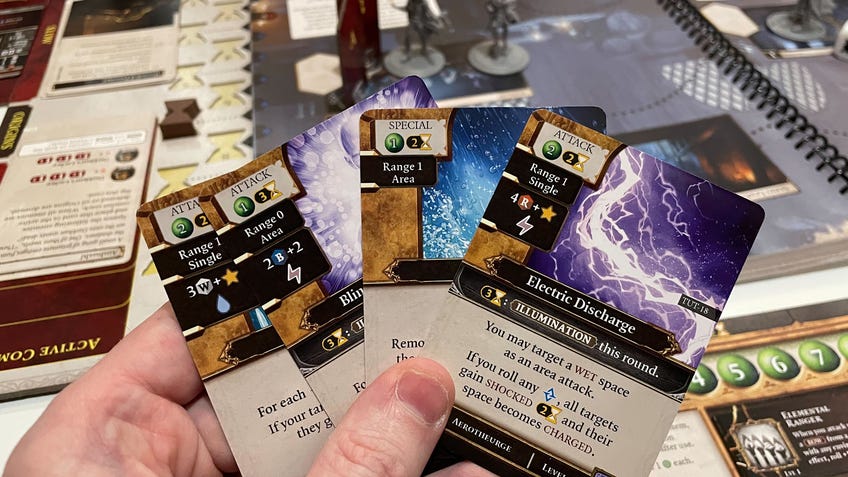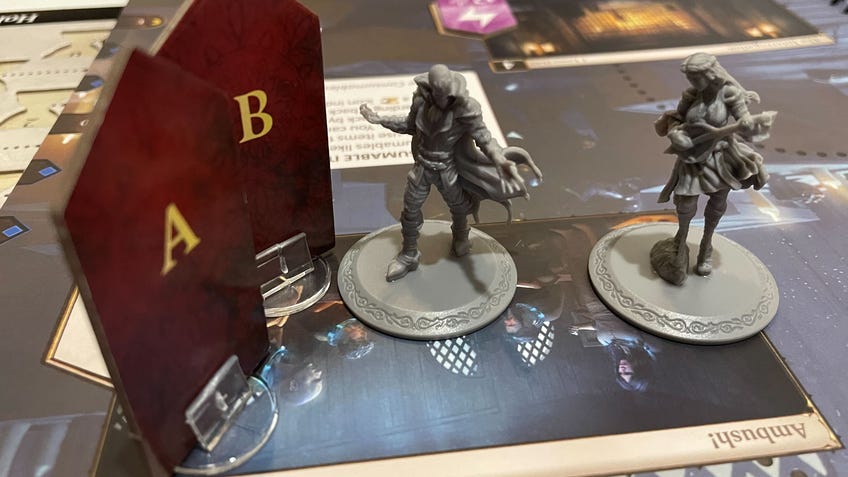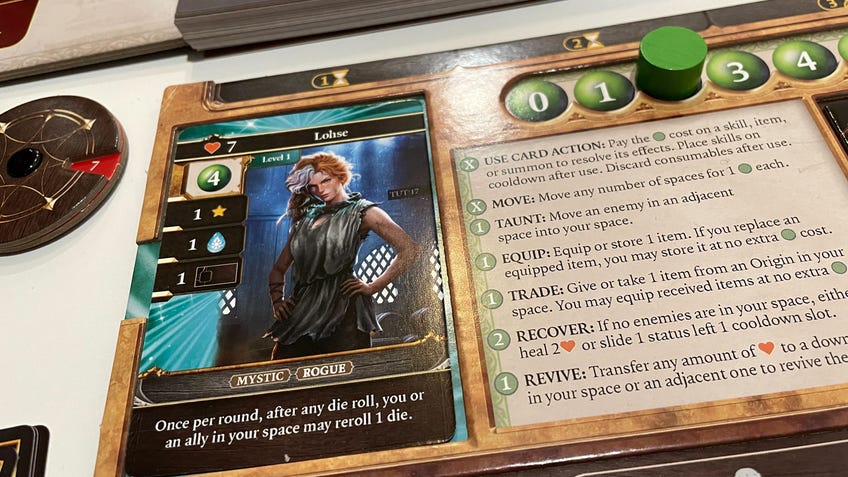Baldur's Gate 3 studio's first board game is just as epic and entertaining as its RPGs
It would be a sin not to.
The first version of Divinity: Original Sin – The Board Game was unremarkable. Having played a preview copy several years ago, it was a largely forgettable experience that felt overly complicated purely because it was based on a video game series that’s known for its complexity.
Fast forward to Essen Spiel 2023 and a representative from Larian Studios, the company behind the board game and last year’s D&D video game Baldur’s Gate 3, describes how the design team for the Divinity board game chose to scrap the original version and redesign it from the ground up.
Though there was no negative feedback from the Kickstarter backers of the upcoming board game, the design team felt a lack of enthusiasm for what they had made. Rather than ship out the first version, the creators behind the board game chose to give the adaptation another try. The fact that Larian was able to take the extra time and money to entirely remake a large board game says something about the company’s current level of success. It’s certainly not something that a lot of studios would have the option of doing.
Nevertheless, when it comes to making a better board game, the gamble has certainly paid off. This new version of the Divinity board game is far superior to the old one, providing an experience that captures the soul of the video game series in a tabletop-first approach that’s enjoyable to play.
The tutorial is easily the most impressive aspect of the board game so far. Instead of dumping an entire novel’s worth of text on its players, Divinity: Original Sin – The Board Game opts to guide its players through its rules via a tutorial. Players can choose from four pre-made characters – each recognisable from Divinity: Original Sin 2 – and find themselves on a ship that is in imminent danger of sinking.
It’s understandable that Larian would want to save money, but I’d expect more for a board game where immersion is important.
Thanks to this tutorial level, you’re able to set the game up and grasp its core gameplay mechanics within 20 minutes – which is a considerable feat considering this is a legacy-style, RPG-inspired adventure board game.
It helps that most of the game is played with a book that opens up to reveal each new location players visit on their journey through Rivellon. In a similar fashion to the excellent Gloomhaven: Jaws of the Lion, the Divinity board game forgoes cumbersome tiles and boards in favour of pages in a book. Not only does this reduce setup time considerably it also makes packing the game away a lot easier.

Every location in the video game board game features a collection of spaces for players to move to and explore. These spaces are connected in various ways, with players sometimes needing to take certain paths or even unlock the way forward to reach them. Whilst some aspects of the game’s presentation look great – such as the character miniatures, boards and cards – the locations themselves look disappointingly bland thanks the use of, what look like, screenshots from the video games over original art. It’s understandable that Larian would want to save money where it could, such as making miniatures for just the player characters, but I’d expect more for an adventure/RPG-esque board game where immersion is important.
The tutorial is where you learn about the combat in Divinity: Original Sin – The Board Game. Depending on whether you’re facing fast or slow enemies, the player/s will go first or second in the turn order. The character order is determined by the players, with the only stipulation being that a character needs to finish their turn before moving onto the next one.
Whilst the Divinity board game doesn’t accurately reflect the intricacies of the original video games, it does offer a fun and engaging combat system.
On their character’s turn, players will have several action points available. Action points can be used to move between spaces and perform various abilities and/or weapon attacks. What abilities and weapons players can use depends on their character, whether they’ve chosen a pre-set character or made their own after the tutorial level. Ability and weapon cards will list what they do and how many action points they cost, with dice being rolled to decide the success of each use. Every attack will have players rolling a certain amount and type of dice whenever they use it, with particular dice colours having different probabilities of success.
As in the Divinity video games, abilities and weapons can have different effects depending on certain elemental statuses present on the targeted space and/or character. Whilst some single-target abilities become area-of-effect, others will cause more damage or trigger other status effects on those they hit. This gameplay system encourages players to think strategically about how to use their abilities in tandem with each other, both to have the maximum impact on their enemies and to avoid friendly fire.
There’s nothing especially complex about Divinity: Original Sin – The Board Game’s combat but it does move quickly, with good and/or bad things happening at a fast pace. Players do have to perform some admin – placing tokens to indicate status effects, turning dials to keep track of health and moving ability cards along a cooldown track – however, it doesn’t feel laborious at all. Whilst the Divinity board game doesn’t accurately reflect the intricacies of the original video games, it does offer a fun and engaging combat system that gives everyone an opportunity to do something cool.
The branching storylines will see players visiting some locations, with the group needing to invest in multiple playthroughs.
Other than fighting, players will be exploring their current location in search of ways to progress, gain new resources or experience more of the game’s story. When exploring, players draw the card for that specific space and read out what it says – preferably in a dramatic fashion. These exploration cards will often feature skill checks for players to try and pass. Each skill check will see one player rolling dice with the aim of getting a certain number of hits. The amount of dice they roll will depend on whether they have any of the traits listed on the exploration card, with certain types of characters being more accomplished at performing certain types of actions – which makes a lot of sense in a roleplaying-inspired board game.

Though the tutorial locations don’t contain much in the way of story, besides a couple of side-encounters, Larian has stated that Divinity: Original Sin – The Board Game will contain a storyline with branching paths and opportunities for individual characters to resolve their own questlines. Each character questline will differ depending on the origin players choose, with the board game containing three entirely original characters not found in either Divinity video game.
Besides exploration cards, story moments will also happen in response to the round marker reaching a particular point for each location. These moments bring a cinematic element to the tabletop experience, making players feel even more like they’re controlling characters within a moving story. For example, the second tutorial location will see the characters having to dodge a kraken attack if they decide to hang around in the bowels of the ship for too long.
It’s fantastic to see Larian turn its back on meticulous overcomplication in favour of streamlined fun, making its first board game well worth checking out.
Once the tutorial is finished, players are free to make their own characters using the available origins, as well as abilities, weapons, items, talents and traits, or otherwise stick with their chosen pre-made character. According to Larian, players will encounter various boss fights in the Divinity board game, each with their own unique gameplay mechanics that will require certain strategies to overcome. Additionally, the branching storylines will see players visiting some locations and not others, with the group needing to invest in multiple playthroughs to witness everything the game has to offer.

A complete playthrough of the Divinity board game requires many sessions, however, you can tell that it’s a good video game adaptation within just a few rounds.
The Divinity board game doesn’t try to replicate as much as possible from its source material to the detriment of the gameplay experience, instead translating the most essential elements in ways that work for the tabletop. It’s fantastic to see Larian turn its back on meticulous overcomplication in favour of streamlined fun, making its first board game well worth checking out.


